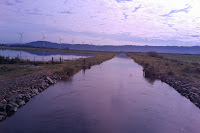During our free time, we explored a Avenida das Rendeiras, a quaint street along the coast of the Lagoa da Conceição. From there we were able to buy some souvenirs, climb some dunes, and grab a hearty Brazilian-style buffet lunch. And we went paddle-boarding too on the lake [I'll have to upload those pictures as soon as I get copies]. All in, we spent about four hours on that part of the island.
 |
| View of the sand dunes. Avenida das Rendeiras is about 20 feet behind where this picture was taken. |
 |
| Street graffiti/ mural along a Avenida das Rendeiras |
 |
| Lagoa da Conceição |
When we returned to the main part of Florianópolis, Dina took us to the Campus Universitário da Grande Florianópolis (UNISUL) to attend a lecture on the state of Brazilian energy. The main speaker was Dr. Baltazar Guerra (full name José Baltazar Salgueirinho Osório Andrade Guerra, PhD), a professor of international relations whose work with the REGSA, a multinational project aimed at bringing sustainable energy to places which recently had zero access to a stable energy grid. The purpose of this lecture however, was the issues surrounding energy generation today, and how they will be compounded in the coming decades as the global population pushes towards 9 or 10 billion people.
A significant percentage of this population growth comes from China and India. Each of these countries are frightening for different reasons. China's population boom threatens the Earth because its government never signed the Kyoto Protocol. Basically, China has no incentive to minimize carbon dioxide emissions, instead choosing cheap, yet dirty burning coal and gas to power its emergence as a global superpower. India's size is scary for a different reason though. A large portion of India's 1.2 billion people do not have access to electricity. What will happen in the coming decades as a larger percentage of Indians gain access to electricty? There is no source for this energy in place today, and engineers will either have to find sources, or subject a significant portion of the human population to blackouts.
Is hydro-power a clean energy source? Hydro-power is a renewable method of energy generation, but this does not make it clean, and it certainly has its drawbacks. When a dam is erected and an area flooded, this creates many environmental concerns. The water destroys ecosystems, forcing animals to adapt, migrate, or die. The new lake occupies land which may be suited to better uses, like growing crops for food, materials, or energy production (using biomass fuels like ethanol). Additionally, as the water rises, tons and tons of vegetation is killed, and this decomposing mass slowly releases huge amounts of methane into the air, contributing to global climate change. Brazil is the place to study the effects of hydroelectric generation, as over 65% of the energy used in Brazil in 2014 came from hydro-power stations. We'll learn more about hydro-power next week though, when we visit Itaipu Dam in Paraná.
*note. It's late, I'm sleepy, and there's many more pictures to upload. I'll update this post when we get more reliable wifi








